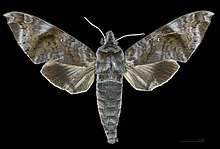Acosmeryx shervillii
Acosmeryx shervillii, the dull forest hawkmoth, is a moth of the family Sphingidae. The species was first described by Jean Baptiste Boisduval in 1875. It is found from the Indian subregion, Sri Lanka, to Sundaland, the Philippines and Sulawesi.[2] Acosmeryx pseudonaga is sometimes treated as a valid species.
| Dull forest hawkmoth | |
|---|---|
.jpg) | |
| Scientific classification | |
| Kingdom: | Animalia |
| Phylum: | Arthropoda |
| Class: | Insecta |
| Order: | Lepidoptera |
| Family: | Sphingidae |
| Genus: | Acosmeryx |
| Species: | A. shervillii |
| Binomial name | |
| Acosmeryx shervillii | |
| Synonyms | |
| |
Description
The colour varieties of the species have been described as separate species many times. However, they are classified as colour morphs of the single species A. shervillii.
According to The Fauna of British India, Including Ceylon and Burma: Moths Volume I by G. F. Hampson:
Geyish brown; the vertex of head dark; pro-, meso-, and meta- thorax each with a dark transverse streak; dorso-lateral oblique dark stripes on each segment of the abdomen. Fore wing with nine curved and waved antemedial dark lines, the interspaces between three of the pairs of lines being filled in with dark brown, so as to form one subbasal and two antemedial bands; a dark-ringed pale speck at end of cell, the pale center being sometimes obsolete; four postmedial curved lines; an oblique dark band from beyond the middle of the costa to outer angle, in some of the forms produced outwards along vein 5 so as to be more oblique; a pale submarginal obsolescent line from below the apex to outer angle, sometimes carried out to the margin at vein 4. Hind wing brownish fuscous, with traces of a pale patch and dark lines near anal angle. Underside more or less suffused with ferruginous, ochreous, and grey; the outer margin of both wings dark; hind wing with five indistinct lines.......larva green; a series of brown dorsal spots and of lateral oblique stripes on 5th to 10th somites; an ocellated spot on 4th somite; a black stripe from 1st to 4th somite, with a yellow line above it; horn brown.
— The Fauna of British India, Including Ceylon and Burma: Moths Volume I[3]
Biology
There are three or more generations in Hong Kong, occurring from early March until early October. The larvae have been recorded on Saurauia, Dillenia, Leea, Cayratia, Cissus and Vitis species.[4]
 Male
Male Male underside
Male underside Female
Female Female underside
Female underside
References
- "CATE Creating a Taxonomic eScience - Sphingidae". Cate-sphingidae.org. Archived from the original on 2012-11-08. Retrieved 2011-10-20.
- "Acosmeryx shervillii Boisduval sp. rev". The Moths of Borneo. Retrieved 5 July 2016.
- Hampson, G. F. (1892). The Fauna of British India, Including Ceylon and Burma: Moths Volume I. Taylor and Francis – via Biodiversity Heritage Library.
- Pittaway, A. R.; Kitching, I. J. "Acosmeryx shervillii Boisduval, [1875] -- Dull forest hawkmoth". Sphingidae of the Eastern Palaearctic. Retrieved December 13, 2018.
External links
- Holloway, Jeremy Daniel. "Acosmeryx shervillii Boisduval sp. rev". The Moths of Borneo. Retrieved January 11, 2019.
| Wikimedia Commons has media related to Acosmeryx shervillii. |